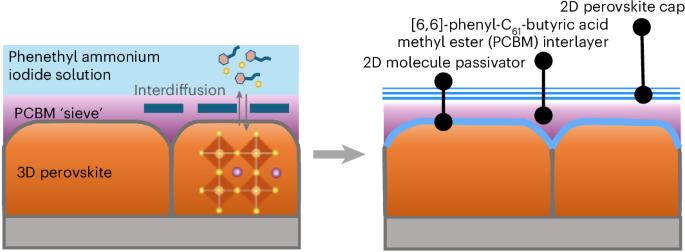Synthesis of a lattice-resolved laminate-structured perovskite heterointerface
IF 20
0 CHEMISTRY, MULTIDISCIPLINARY
引用次数: 0
Abstract
Two-dimensional surface passivation has been shown to be useful for achieving state-of-the-art perovskite optoelectronics, and the microstructural and phase heterogeneities of two-dimensional perovskite passivators can influence their roles. However, the synthesis of co-homogenized, stable microstructure and phase in such passivators remains challenging. Herein we leverage a [6,6]-phenyl-C61-butyric acid methyl ester molecular interlayer to mediate the reaction of the two-dimensional passivator and perovskite, leading to a uniform purer-phase two-dimensional perovskite capping layer. This interlayer mitigates the grain-boundary etching encountered in conventional approaches, creating molecular passivation directly onto the perovskite surface. The inverted perovskite solar cells made with the interlayer feature a laminate-structured perovskite heterointerface at the electron-extracting side, which contributes to improved charge energetics and film stability, owing to the regulated band alignment and laminate-layer protection, respectively. Power conversion efficiencies up to 25.97% are achieved, together with enhanced device stabilities under protocols standardized by the International Summit on Organic Photovoltaic Stability, showing T90 lifetimes (the time at which they maintain 90% of their efficiency) of over 1,000 h in both the damp-heat test (85 °C, 85% relative humidity) and maximum power point tracking under one-sun illumination. Lattice-resolved insights are provided to link the microstructure to device performance, shedding light on the significance of passivator-microstructure uniformity and reliability on the performance of perovskite optoelectronics. A method mediated by [6,6]-phenyl-C61-butyric acid methyl ester (PCBM) is developed to synthesize a uniform, purer-phase 2D perovskite capping layer on 3D perovskite films. The PCBM interlayer mediates the reaction of the 2D passivator with the 3D perovskite and prevents grain-boundary etching, enhancing solar cell efficiency and stability.

晶格分解层状结构钙钛矿异质界面的合成
二维表面钝化已被证明对实现最先进的钙钛矿光电子器件是有用的,二维钙钛矿钝化剂的微观结构和相异质性会影响它们的作用。然而,在这种钝化剂中合成共均质、稳定的微观结构和相仍然是一个挑战。本文利用[6,6]-苯基- c61 -丁酸甲酯分子中间层介导二维钝化剂与钙钛矿的反应,形成均匀的纯相二维钙钛矿封盖层。这种中间层减轻了传统方法中遇到的晶界蚀刻,直接在钙钛矿表面产生分子钝化。利用该中间层制备的倒置钙钛矿太阳能电池在电子提取侧具有层状结构的钙钛矿异质界面,这分别由于调节能带对准和层状层保护而有助于提高电荷能量学和薄膜稳定性。在国际有机光伏稳定性峰会标准化的协议下,实现了高达25.97%的功率转换效率,同时增强了设备的稳定性,在湿热测试(85°C, 85%相对湿度)和单太阳照射下的最大功率点跟踪中,T90寿命(保持90%效率的时间)均超过1,000小时。提供了晶格解析的见解,将微观结构与器件性能联系起来,揭示了钝化器微观结构均匀性和可靠性对钙钛矿光电子性能的重要性。以[6,6]-苯基- c61 -丁酸甲酯(PCBM)为媒介,在三维钙钛矿薄膜上合成了均匀、纯相的二维钙钛矿封盖层。PCBM中间层可以调节二维钝化剂与三维钙钛矿的反应,防止晶界腐蚀,提高太阳能电池的效率和稳定性。
本文章由计算机程序翻译,如有差异,请以英文原文为准。
求助全文
约1分钟内获得全文
求助全文

 求助内容:
求助内容: 应助结果提醒方式:
应助结果提醒方式:


